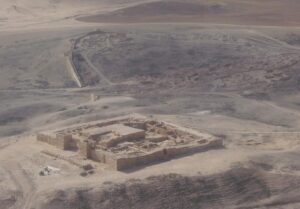Excavating the missing link in the water-system of the Israelite fortress
Arad is actually a double site—a large and spacious 25-acre Canaanite city and a small, three-quarter-acre Israelite fortress. The ancient sites are situated on a bowl-shaped hill six miles from the attractive, modern, desert city of Arad in the Negev. The Israelite fortress is on the northeastern height of the hill. Below this Israelite citadel (11th to 6th centuries B.C.) stretch the extensive remains of the Canaanite settlement (3200–2650 B.C.), the latter encircled by its distinctive city wall interrupted by 11 extant round towers.a Two gateways to this city have been excavated.
The configuration of the bowl-shaped hill invites a certain kind of human use—settlement on the slopes and use of the low center to collect seasonal rain water and runoffs.
Indeed, our assumption from the start of our excavations in 1962 was that the depression in the hill concealed the water-supply system of the Canaanite city. While slowly progressing with the excavations during 18 seasons between 1962 and 1984 we realized that this assumption was not only correct, but twice and three times correct. In this depression we uncovered the water supply of the three major periods of settlement at Arad. This water-supply was used in the Early Bronze Age Canaanite city, again in the Israelite period (to provide water to the Israelite fortress) and, so it appears, again in the Herodian period.
Read the rest of The Well at Arad in the online Biblical Archaeology Society Library.
